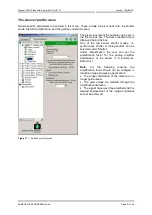
Version 1.08 (04/07)
Manual: CMOS Industrial Camera LOGLUX
i5
Page 8 of 46
KAMERA WERK DRESDEN GmbH
The shutter modes of the IBIS5 sensor
The IBIS5 has two shutter modes, viz. the
rolling
or
curtain shutter
mode and the
synchronous
or
snapshot shutter
mode. The working principles and resultant characteristics of the two shutter modes
are described below.
The working principle of the
rolling
or
curtain shutter
can be described by means of the following
graphic representation:
As is shown in Figure 4 (left), an object is imaged by recording individual lines. The capturing of a line,
in turn, is subdivided into three phases: resetting all pixels of a line, integrating all pixels of a line, and
reading out all pixels of a line. The content of a picture element of an image is not fixed until the
integration phase is completed. It should be noted that the integration phase for line 7, for example,
will not start until the integration phase for line 1 is complete.
When the camera is set to the ‚
rolling/curtain shutter
‘ mode and an attempt is made to capture a
moving object whose motion vector is normal to the sensor line readout vector, it can easily be seen
that the image of the moving object is distorted (Figure 4, right side). The degree of image distortion is
determined by the relation between sensor line readout speed and object speed. In most cases, this
distortion effect is unacceptable for image processing.
For this reason, the ‚
rolling/curtain shutter
‘ mode should, where possible, only be used for imaging
objects that do not move, or move slowly relative to the sensor line readout speed. In this case,
however, the image can be captured at very high image rates.
The working principle of the
central
or
snapshot shutter
mode can be described by means of the
following graphic representation:
As is obvious from Figure 5 (left side), the object is here, too, produced by recording individual image
lines, and a line is also captured in three phases: resetting all picture elements of a line, integrating all
pixels of a line, and reading out all pixels of a line. But in contrast to the ‚
rolling/curtain shutter
‘ mode,
the reset and integration phases for all lines are connected up in terms of time. Only reading out the
individual lines is separate. This approach reveals a big advantage over the ‚
rolling/curtain shutter
’
mode: The image of a moving object is free of distortions (Figure 5, right side). However, this
advantage is at the price of the image rate: A comparison of Figures 4 and 5 (left sides) shows that the
‚
central/snapshot shutter
‘ mode does not permit a time-staggered readout of the sensor lines.
The ‚
central/snapshot shutter
‘ mode should be used whenever undistorted images of moving objects
are needed. Compared with the ‚
rolling/curtain shutter
’ mode, the image rate is lower.
Figure 5 :
Working principle of the rolling/curtain shutter and the imaging of moving objects
Figure 6 :
Working principle of the central/snapshot shutter and the imaging of moving objects























